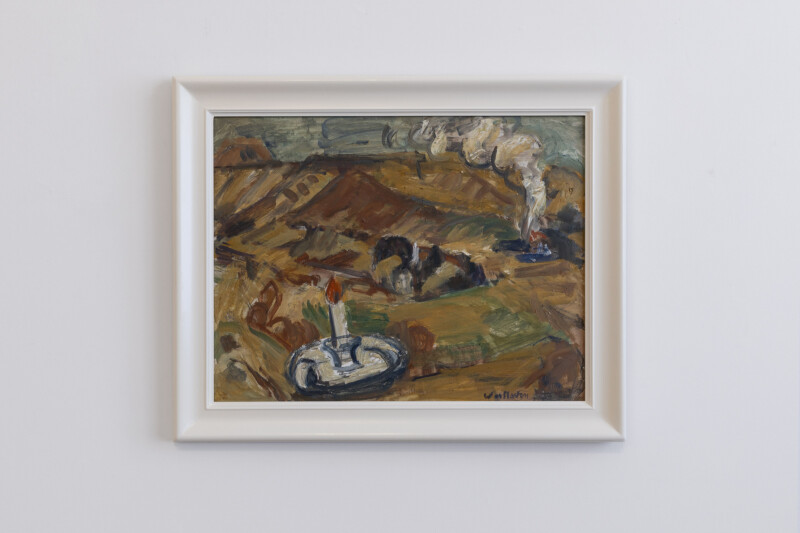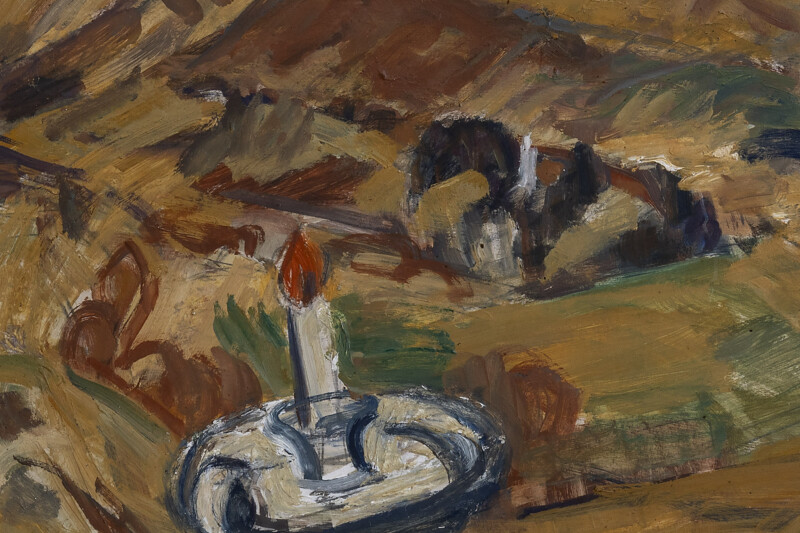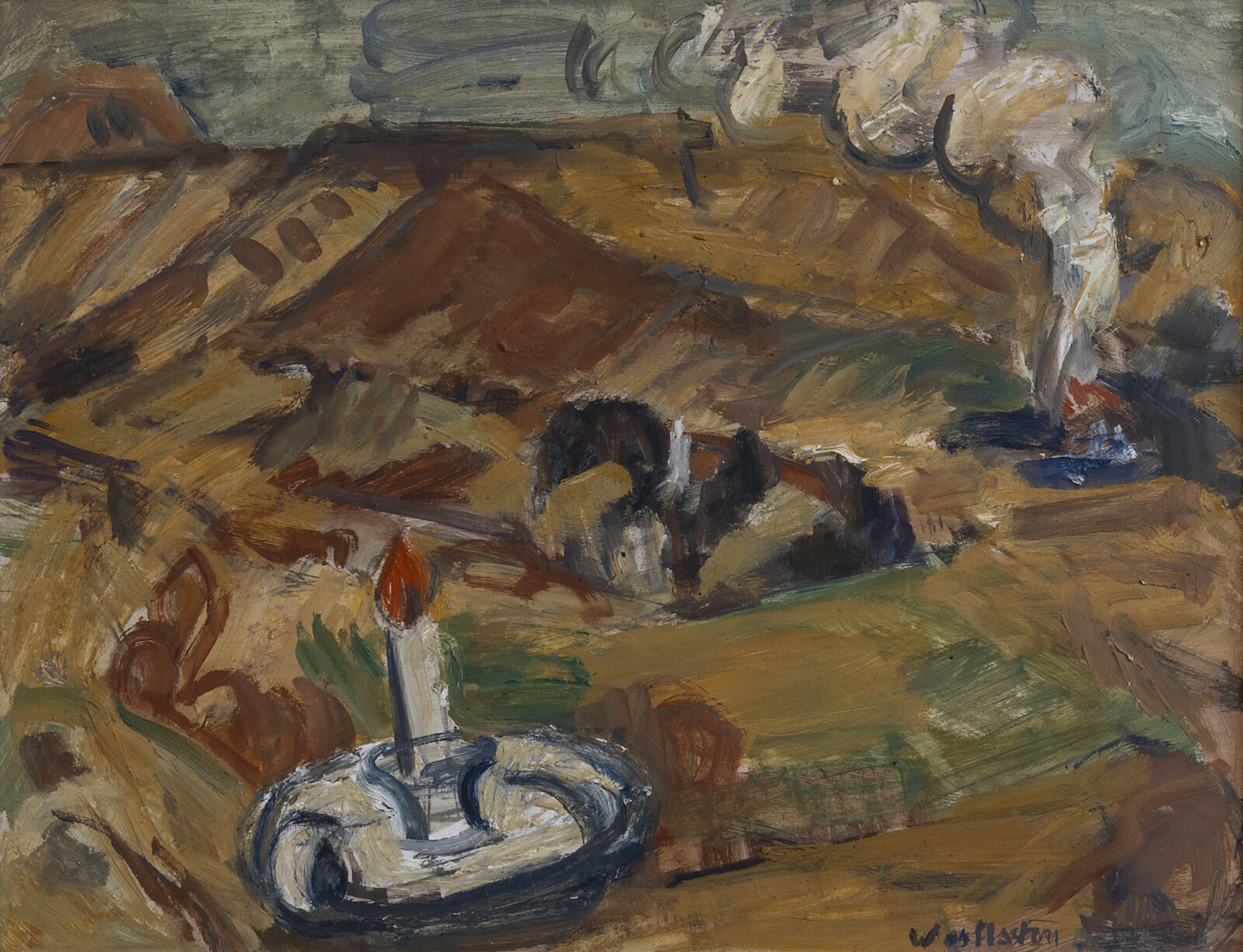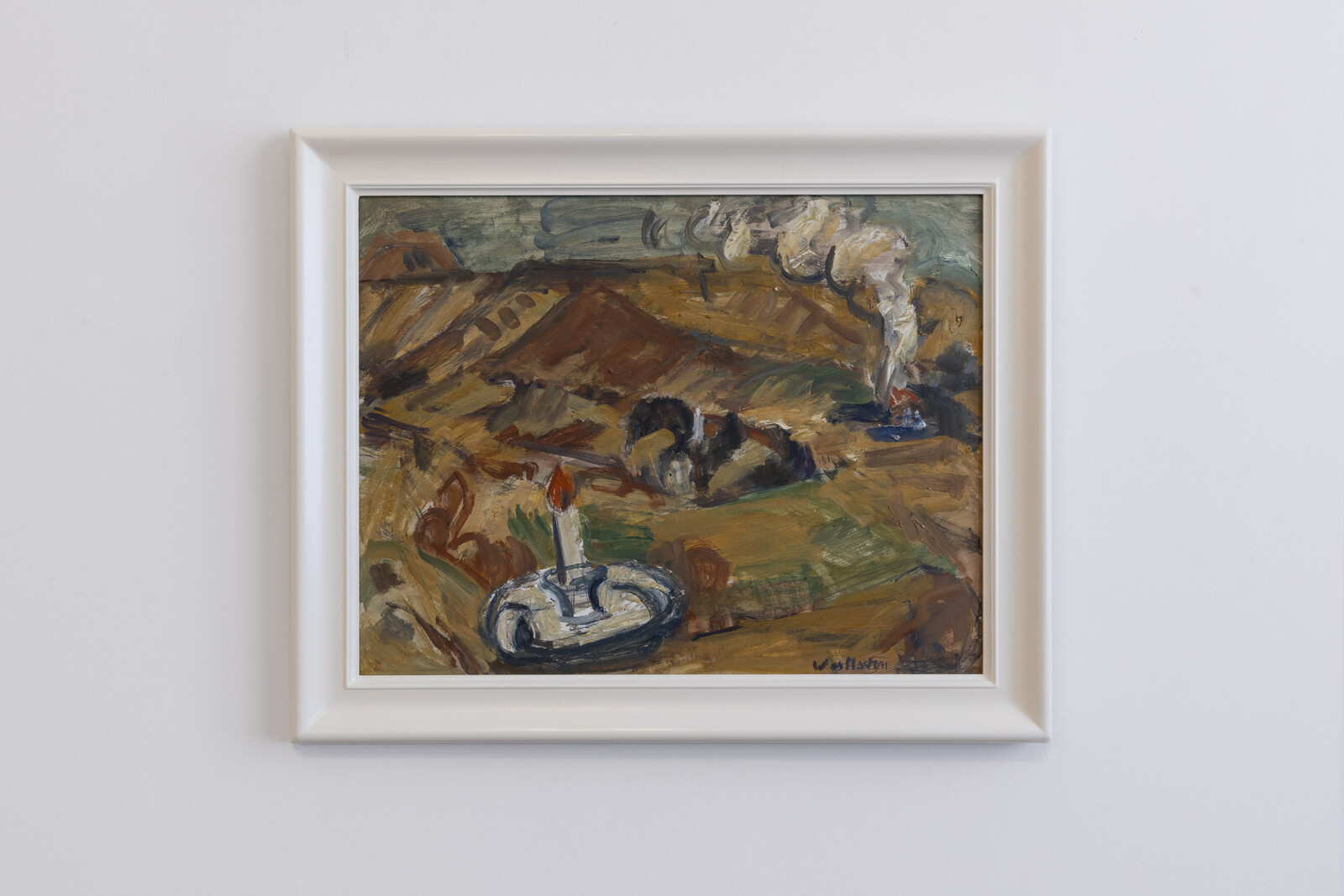WOOLLASTON, Toss;
Candle and Fire, Upper Moutere
c.1946
Oil on board
560 x 690mm



Research into this painting by Toss Woollaston is ongoing. An inscription on a former backing board gives the title Candle and Fire, Upper Moutere and dates the work c. 1946. At this time, Woollaston was living at Māpua, not far from Whakatū Nelson, with his wife, Edith, and their young family. He was focussing on two types of work: portraits and landscapes. Māpua was a regular subject of his work, as was nearby Upper Moutere.
Candle and Fire, Upper Moutere is one of two known oils depicting a candle and fire. The other, Candle in Moutere Landscape (c. 1946), is very similar in composition. It appears to be the earlier of the two works and might be a highly developed preparatory study for Candle and Fire, Upper Moutere. It is smaller, measuring about 340 x 440mm, and more thinly and loosely painted. White underpainting and lively pencil lines show through the brushwork in places. Woollaston’s signature is in pencil. In 1954, the painting was exhibited at the Architectural Centre Gallery, Te Whanganui-a-Tara. It was purchased by Ruth Mary Allan (née Fletcher; 1918–58), a historian of the Nelson region, and it remains in the collection of a descendant of her husband’s.[1]
An oil titled Candle in the Sun was included in the 1952 Group Show, held at Durham Street Art Gallery, Ōtautahi. It is unclear whether this was Candle in Moutere Landscape, Candle and Fire, Upper Moutere, or another work altogether. The show also included paintings created in Māwhera Greymouth, which became the Woollaston family’s home in late 1949.
Candle and Fire, Upper Moutere is marked by fluid brushwork and earthy, naturalistic tones consistent with many of Woollaston’s oils of the 1940s. The content is unusual. While a fire appears in a later work, Landscape with Fire (c. 1960), now in Ngā Puhipuhi o Te Herenga Waka—Victoria University of Wellington Art Collection (VUW.1961.5), the presence of the large burning candle in the foreground is surprising. Woollaston sometimes painted views through windows, but—with the obvious exception of Candle and Fire, Upper Moutere—no other work presently known places a domestic object in a landscape, much less a light source in a daylit landscape.
The significance of the candle for Woollaston is not clear. He and his family certainly used candles. The house at Māpua did not have electricity, a situation reflected in Edith with a Lamp (1942), in the collection of the National Gallery of Victoria, Naarm Melbourne (91-5). The artist’s son, Philip, remembers the enamel candleholder depicted in this painting. In the 1940s, Woollaston spent much time working as an orchardist to support the family, and it is not difficult to imagine him working on his art by candle-light. Candle and Fire, Upper Moutere could almost be a painting of a candle before a painting of a landscape.
The candle itself calls to mind near-contemporary works by Woollaston’s good friend Colin McCahon, such as The Promised Land (1948). The motif might have Christian or vanitas symbolism. It might represent enlightenment, guidance, hope, intellect, and truth. Juxtaposed with the smoking fire, it might be intended as a reference to the Second World War, advocating remembrance. (Like Rita Angus and Leo Bensemann, Woollaston was a pacifist.) The candle could be a creative force, and the fire a destructive one. Equally, it could be the spiritual realm, and the fire the physical realm. As someone who not only painted the land but also worked it, Woollaston might have seen the two flames as representing two kinds of cultivation, cultural and agricultural, or two kinds of labour, artistic and technical.
The candle may also be a literary reference. Woollaston was very interested in literature (in his youth he aspired to be a poet), and there are references to candles in various texts with which he is known to have been familiar, including poems by Mary Ursula Bethell (1874–1945), whom he knew well, and Gerard Manley Hopkins (1844–89). The Marriage of Heaven and Hell (1790), by the Romantic artist and writer William Blake (1757–1827), includes an especially resonant reference:
‘Have now another plain fact: any man of mechanical talents may from the writings of Paracelsus or Jacob Behmen produce ten thousand volumes of equal value with Swedenborg’s, and from those of Dante or Shakespeare an infinite number.’
‘But when he has done this, let him not say that he knows better than his master, for he only holds a candle in sunshine.’[2]
It is probable that Woollaston was aware of The Marriage of Heaven and Hell in the 1940s. In 1972, he made reference to the book in a letter to his lover, Faye Hill.[3] If this text were his intended reference, then the painting might express the difficulty of achieving artistic originality or maintaining spiritual integrity. It is interesting to note that the mid-1940s saw Woollaston break with a major influence on his religious life, his uncle, Frank Tosswill.[4] Tosswill, who also had an impact on McCahon’s spiritual thought, was an ‘Oxford Grouper’, or follower of the American Lutheran minister Frank Buchman, who claimed to be guided by the Holy Spirit.[5] He was critical of Woollaston’s art, deeming it of little spiritual importance. This attitude no doubt contributed to Woollaston’s disenchantment with him.
The reverse of Candle and Fire, Upper Moutere carries a second painting by Woollaston. Philip Woollaston has identified the subject as a group of houses on Stratford Street in Māwhera. Frances Buckley has noted, ‘This enclosed area, available only to foot traffic, between Alexander and Blackmore streets was given the name “Holy City” because the original twelve houses dubbed “the twelve apostles” were occupied by Catholic families who visited church on a very regular basis.’ Woollaston often painted on two sides of the same support in the 1940s due to a lack of materials. To date, no reference to the picture of the ‘Holy City’ has been traced, and it was likely abandoned by the artist. The work is unsigned.
Candle and Fire, Upper Moutere entered the collection of Hilary and Peter McLeavey, Te Whanganui-a-Tara, in the late 1960s or early 1970s. Peter McLeavey (1936–2015) was Woollaston’s agent and dealer, and he played an important role in supporting Woollaston as he transitioned into a full-time career as an artist. When Peter opened his gallery on Cuba Street in 1968 it was with a solo exhibition by Woollaston comprising pictures of Bayly’s Hill in Taranaki. Hilary was drawn to the show by a positive review in the Dominion (9 September 1968), written by Margaret Orbell, wife of another McLeavey artist, Gordon Walters. There she met Peter. The two soon married, and they became close friends of Toss and Edith Woollaston.
Hilary remembers Candle and Fire, Upper Moutere as ‘an early purchase after we fell in love and married’. She also observes: ‘I had grown up outside Nelson and this landscape was very familiar to me. I love the earthy tones, the sense of layers of hills, and the candle suggesting, to me, warmth, hope and a certain mystery.’ The work was seemingly sold to the McLeaveys directly by Woollaston. It is unclear why it was still in his possession so long after its making. Had it been shown and not sold, or had he withheld it? Was he dissatisfied with the piece for some reason, or was he especially satisfied with it? Whatever the situation, it is clear that Peter and Hilary valued the painting greatly. Today, it can be appreciated as an emblem of two important relationships, one between Hilary and Peter, the other between them and Woollaston.
[1] Jill Trevelyan, Toss Woollaston: A Life in Letters (Te Whanganui-a-Tara: Te Papa Press, 2004), 199n8.
[2] William Blake, The Marriage of Heaven and Hell (Boston: John W. Luce and Company, 1906), 356.
[3] Trevelyan, Toss Woollaston: A Life in Letters, 356.
[4] Ibid., 492.
[5] Gerald Barnett, Toss Woollaston (Tāmaki Makaurau: Random Century; Te Whanganui-a-Tara: National Art Gallery, 1991), 55.
Inscriptions
Woollaston [l.r.] Candle and Fire, Upper Moutere / M. T. Woollaston ; c. 1946 [verso]Exhibition History
Richard Killeen, Peter Robinson, Charles Tole, and Toss Woollaston, Personal Stories, McLeavey Gallery, Te Whanganui-a-Tara, 7 to 28 October 2023
? Group Show, Durham Street Art Gallery, Ōtautahi, 25 October to 9 November 1952, cat. no. 66
Provenance
2023–
Fletcher Trust Collection, purchased from McLeavey Gallery, Te Whanganui-a-Tara, October 2023
2015–23
Collection of Hilary McLeavey, Te Whanganui-a-Tara
c. 1970–2015
Collection of Hilary and Peter McLeavey (1936–2015), Te Whanganui-a-Tara
c. 1946–c. 1970
Collection of the artist?



